As an Amazon Associate I earn from qualifying purchases.
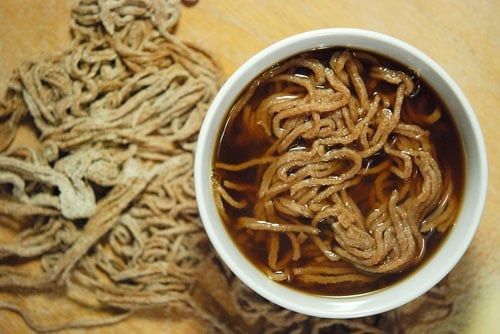
Making stocks and broths are among the core skills of any good cook, and it is a labor or love I embrace wholly. As a hunter, angler and a gardener, I can often make a first-class stock solely with ingredients I’ve grown, caught or shot. This to me is deeply satisfying. Venison stock is one of my mainstays throughout the year.
While some will make a stock without vegetables, I am not among them. They add so much to the final flavor of a stock and can transform it from an additive into a full-fledged broth suitable for drinking on cold days. Incidentally, while I use stock and broth interchangeably, technically a stock is a base and a broth something you can serve on its own; generally a broth is more flavorful and better seasoned than a stock.
Other than the venison, my essentials are: Onions or leeks, carrots, celery, bay leaves, parsley. I will add other herbs as appropriate, most often rosemary and thyme, and sometimes juniper berries. Secret weapon for venison stock: parsnips. Their sweetness brings a lot to the party.
First step is roasting the bones. I like darker, fuller stocks and this is what does it. I roast my deer bones at 400°F for an hour or so, until they are yummy-looking. Incidentally, meat makes better broth, so add some if you can. Secret trick: Save all the gnarly, sinewy bits and trim not even fit for the grinder and roast them along with the bones; don’t include bloodshot meat, though.
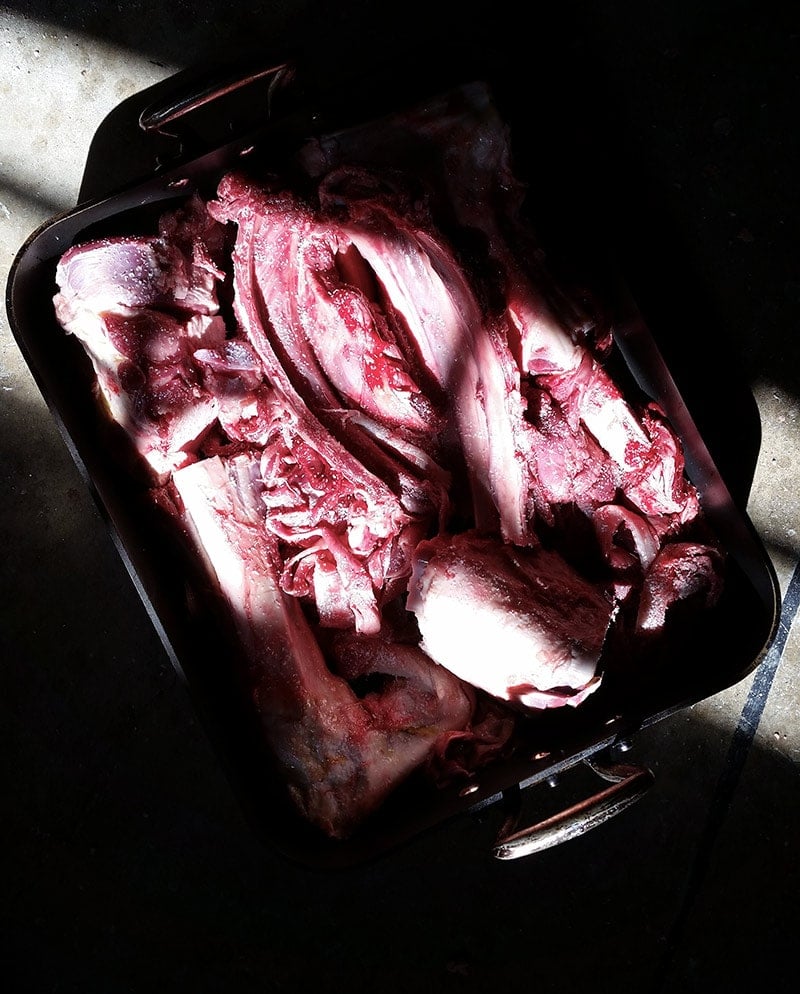
Next cram your bones and trim into the stockpot and cover with cold water by several inches. Cold water will you produce more collagen, and it’s collagen from the joints and cartilage and skin that builds body in your stock by making it thicker than water. You only get this by letting the water heat gradually. Secret trick: Go to the butcher and buy a calf’s or pig’s foot and add it to the pot (don’t roast it, though). It will add a huge amount of body to your broth.
Bring the broth to a boil and skim off any scum that floats to the surface. After the surface is clear, reduce the heat to a bare simmer. You want it to shimmy, not roil, not even bubble too much. A boiled stock will turn cloudy, and the higher temps can extract bitter flavors from the bones. Let it do this for several hours. How long? Up to overnight.
After the meat has infused the water to your liking — 4 hours is a minimum for me — add your veggies, roughly chopped. Remember that old, crappy veggies will not improve by cooking them. That said, the ends of things make great stock, as do onion skins, which will help turn a broth a lovely brown. Stir in your nice vegetables and let it cook for another 90 minutes to 2 hours. No more.
After this, strain everything out. Grab all the big stuff with tongs first, then set a paper towel into a fine mesh sieve. Ladle your venison stock through this into a large bowl or plastic bin. Is all of this necessary? Yes. Unless you want a mucky, cloudy stock. And it is more than aesthetics: The impurities are just that – impure, and add off-flavors to your otherwise wonderful brew.
Once your stock is strained, clean the stockpot or pour the strained liquid into another one. Now you can reduce it if you want to.
This is also the time you can salt the stock. Stock gets saltier the longer you cook it down because salt does not evaporate with the water. So add it close to the end and you will know what you’re getting. If you’re doing demi-glace, don’t salt at all.
All of this takes time, but not a lot of it is active. And the process is comforting to me, as much so as the reward.
Venison Broth
Ingredients
- 4 pounds venison bones, with some meat on them
- 4 tablespoons olive oil
- Salt
- 1 tablespoon crushed juniper berries (optional)
- 2 tablespoons fresh rosemary
- 1 tablespoon crushed black peppercorns
- 1 tablespoon dried thyme
- 4 bay leaves
- 1 medium onion, chopped
- 2 large carrots chopped
- 2 celery sticks chopped
- About 1/2 of a bunch of parsley chopped
Instructions
- Coat the bones with olive oil and salt well, then roast in a 400°F oven until brown. If you can stand it, keep some meat on the bones — trim and shanks are ideal for this. It will make a better broth. Put the bones in a large stockpot. I saw the bones into large pieces with a hacksaw; this lets me fit more bones into the pot, again, making a richer broth. Cover with water and bring to a simmer over medium-high heat.
- Skim the froth that forms on the surface and simmer very gently for at least 4 hours; I let it go overnight. You want the broth to steam and burble a little, not roil.
- Add the remaining ingredients and simmer for another 2 hours.
- Using tongs, grab out all the bones and large bits and discard. Set a paper towel in a fine-mesh sieve that is itself set over another large pot. Ladle the venison broth through the cheesecloth-lined sieve. Discard the dregs in the broth pot, with will be loaded with sediment and other bits.
- Add salt to taste to the clarified broth and pour into quart jars and freeze (or pressure-can — you cannot can broth in boiling water). If you freeze, leave about 2 inches of space at the top of the jar or the jars will crack when the broth freezes. Use within a year.
Notes
Nutrition
Nutrition information is automatically calculated, so should only be used as an approximation.

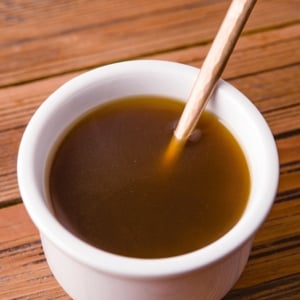
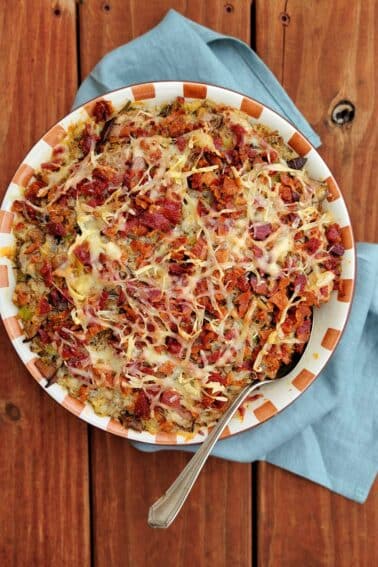

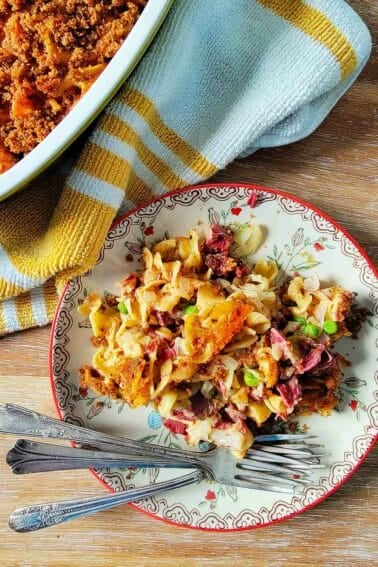
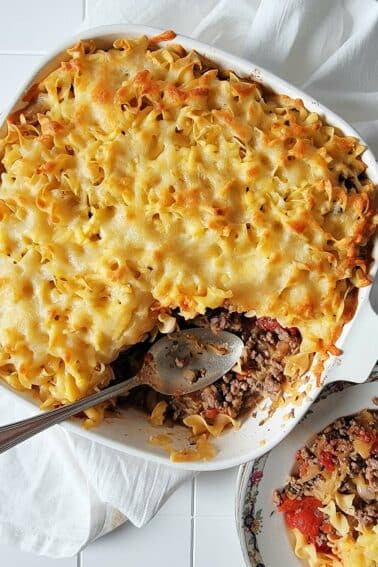
Which bones lend themselves to better broth? I will not likely use all the bones from a deer, but rather the “choice bones”. The large femur, with all that marrow is nice, but what about the very easy to get ribs. I could stuff more volume of ribs into a pot than I could for the large marrow bones but is it a quantity vs. quality issue. There is more work involved in cutting up the marrow bones in order to get more in. What about the lower legs of deer? If skinned and cleaned will they provided additional collagen in lieu of the pigs feet. Or are they just not worth the extra effort?
Kyle: I’ve used everything before, and I prefer the ribs because you can never get all the meat off them, which makes for a better stock. Ditto for the vertebrae, although you want to avoid this if you are in an area where there is Chronic Wasting Disease. Shanks are pretty good, too.
Hi, thank you for this – very interesting post. I am going to attempt this when I get the chance. My experience with venison however is that the fat tastes awful, kind of waxy, and one has to be quite careful in removing it from sausage meat or if you are roasting a leg for example. Have you any thoughts on how careful you need to be with regards venison fat going into the pot? can you just put it in the fridge and take of the fat when it hardens. Thanks again and keep up the good work.
Max: Venison fat is delicious when it is piping hot, but when it cools, as you say, it gets waxy. The taste is fine, the mouthfeel is awful — there’s a difference. In stock, it’s fine in small amounts when the stock is hot, but I generally remove most fat from my stocks no matter what they are made from.
What kind of bones do you use (legs, hips, ribs, etc.) and do you cut to resize for pot?
Cheryl: Mostly leg bones, and yes, I saw them to fit into the pot.
I’ve been making venison stock for years and use it to make French onion soup. It is THE BEST
First time attempting venison stock after my fiancé shot his first 8 point early December. Ended up with about 6 jars which I then froze half for later and used half for a chili recipe and then this recipe from Publix: https://www.publix.com/aprons-recipes/kale-and-farro-stew. Was a longer process than I expected, but worth it. Thanks for sharing! No food to waste. Grateful for the opportunity to harvest our own meat and humbly respect Mother Nature and the circle of life.
Trying the broth with apples and honey as well as rhe other ingredients. Will let you know how it turns out.
How long do I pressure can the stock?
Elizabeth: Follow your canner’s directions. Mine says to vent 7 minutes, put on the 10 pounds of pressure weight, when it jiggles, set the timer for 25 minutes.
I tried out this recipe and my stock ended up being grayish-green instead of brown. I don’t have a stock pot so I used a cast iron dutch oven. The stock still tasted ok but the color is kind of gross looking. Do you think it was just the cast iron or did I do something wrong? thanks.
Giles: Yes, the iron changes things, and you probably did not roast the bone strongly enough.
I just tried to make some venison bone broth, we read online its supposed to simmer for up to 24 hours even up till the bones were soft. We did about 12 hours (roasted for about 45 mins first).
We didn’t add any extra flavour except bay leaves and apple cider vinager. In the past my bone broth was gelatinous when cool, but this one is liquidy still… Does that mean its bad? Did i just waste all my venison bones?!
Janelle: I have no idea what bone broth is. I know this is stock, and what you described is stock. So you’re fine. It is likely not gelatinous because there was no cartilage in the mix. No cartilage, no collagen, no gelatinous finish.
Do you add the dry spices with 2 hours left like the onions/carrots/celery? Or are they added earlier?
Jason: I tend to add the herbs and spices early.
Hey Hank. Have you ever tried whitetail deer bones for broth?
Thanks
Justin
Justin: Yes, they work fine.
Hi Hank,
What type of stock pot would you recommend making this in? I love cast iron, so most of what I make is done in my Lodge cast iron skillet. Would this recipe turn out if I used my handy dandy Lodge cast iron Dutch oven?
Thank you!
Annie: I’ve never made stock in an iron pot, as I always use steel. But it should be fine.
I have found that after making stock, the “spent” meat can be separated from the bones and pan fried until crispy like hashbrowns, This makes an excellent taco filling, at a cost of the dogs not getting a great treat.
Would I be able to sub this in for recipes that call for beef broth? Are there any specific bones that produce more flavor than others?
Killer: Yes. And I haven’t noticed one bone providing more flavor than another.
Could you use the deer’s hoof in lieu of a calf or pig foot?
Danielle: In theory. But you’d need to skin it fully, and it would need to be from a young deer, as collagen is highest in young animals.
Thank you do much for posting your views on cooking with bones. I am currently on the Atkins diet . I have always been a big fan of broths. I would even take a thermos filled with chicken broth to sip on while hunting,(BOW), My other hunting buddies would bring coffee. Maybe that is why I was more successful:) Just kidding I have always concentrated on stocks of all kind. I find drinking stocks is satisfying. I just got a call from my hunting bud while writing this post and he nailed an 8 pointer,(Whitetail). I am going over to help him skin and butcher. That is awesome to me. You cut it up to your own specs. I am going to have Venison broth in the next few days. But in the mean time, I have a feeling it is going to be beer and back straps tonight.
Z, out
Do you add water as it evaporates during the process?
Jessica: No. I fill the pot completely when I start.
Thank you for such good instruction. My Cow Elk Femur’s are simmering from overnight.
How do you store this amazing broth for future uses?
Pyper: I either freeze it or pressure can it.
In researching old traditional recipes for bone broth…it is suggested to cook the broth slowly for up to 10 to 12 hours. This will be my first time making a venison broth…do you recommend simmering it this long?? I am attempting to make it for the medicinal properties?
Amber: I have no idea about medicinal properties. But I have simmered bones and meat for 10 hours before and it was fine.
I am going to try this with some bones from an elk that my nephew got the other day, I’m new to this so wish me luck!